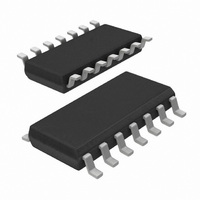AU5790D14/N,112 NXP Semiconductors, AU5790D14/N,112 Datasheet - Page 16

AU5790D14/N,112
Manufacturer Part Number
AU5790D14/N,112
Description
IC CAN TRANSCEIVER 14-SOIC
Manufacturer
NXP Semiconductors
Series
AUr
Type
Transceiverr
Datasheet
1.AU5790D112.pdf
(20 pages)
Specifications of AU5790D14/N,112
Number Of Drivers/receivers
1/1
Protocol
CAN
Voltage - Supply
5.3 V ~ 27 V
Mounting Type
Surface Mount
Package / Case
14-SOIC (3.9mm Width), 14-SOL
Lead Free Status / RoHS Status
Lead free / RoHS Compliant
Other names
568-3054-5
935277456112
AU5790D14/N
935277456112
AU5790D14/N
Philips Semiconductors
Power Dissipation
Power dissipation of an IC is the major factor determining junction
temperature. AU5790 power dissipation in active and passive states
are different. The average power dissipation is:
where:
where:
where:
where:
Table 4. Representative Power Dissipation Analyses
By knowing the maximum power dissipation, and the operation ambient temperature, the required thermal resistance without tripping the
thermal protection can be calculated, as shown in Figure 7. Then from Figure 5 or 6, a suitable PCB can be selected.
2001 May 18
Nodes
Single wire CAN transceiver
10
20
32
10
20
32
2
2
P
P
P
Dy is duty cycle, which is the percentage of time that TxD
is in an active state during any given time duration.
At passive state there is no current going into the load. So
all of the supply current is dissipated inside the IC.
V
I
In an active state, part of the supply current goes to the
load, and only part of the supply current dissipates inside
the IC, causing an incremental increase in junction
temperature.
P
mode;
P
I
V
I
BATPN
BATAN
LOADN
tot
INT
PNINT
BAT
BATAN
LOADN
CANHN
is total dissipation power;
R
is dissipation power in an active state;
284.4
284.4
4550
4550
is the battery voltage;
LOAD
910
455
910
455
( )
is active state supply current in normal mode;
is the passive state supply current in normal mode.
is dissipation power in a passive state;
is current going through load in normal mode.
P
is active state battery supply power in normal
is load power consumption in normal mode.
is bus output voltage in normal mode;
tot
P
P
LOADN
= P
P
P
INT
BATAN
PNINT
V
INT
= P
BAT
13.4
13.4
13.4
13.4
26.5
26.5
26.5
26.5
*Dy + P
= V
= V
BATAN
= V
(V)
CANHN
BAT
BAT
PNINT
– P
* I
* I
I
BATPN
(mA)
* I
BATPN
BATAN
LOADN
2
2
2
2
2
2
2
2
LOADN
* (1-Dy)
P
(mW)
26.8
26.8
26.8
26.8
PNINT
53
53
53
53
V
CANHN
4.55
4.55
4.55
4.55
4.55
4.55
4.55
4.55
(V)
16
I
where:
Assumptions:
Computations:
Additional examples with various node counts are shown in Table 4.
(mA)
LOAD
10
16
10
16
1
5
1
5
A power dissipation example follows. The assumed values
P
tot
= 396.2 mW
I
normal mode.
I
decreases. To simplify this analysis, we will assume I
fixed.
I
table.
are chosen from specification and typical applications
INT
INT
BATN
I
(mA)
BATN
I
20
24
29
35
20
24
29
35
INT
is an active state current dissipated within the IC in
will decrease slightly when the node number
P
P
P
(32 nodes) may be found in the DC Characteristics
INT
P
LOADN
= I
BATAN
I
PNINT
LOAD
R
I
= 469 mW - 72.8 mW = 396.2 mW
BATN
INT
LOAD
I
I
BATN
I
INT
LOAD
= 35 mA - 16 mA = 19 mA
= 4.55 V / 284.4
= 4.55 V
= 13.4 V
50% + 26.8 mW
= 13.4 V
I
BATN
(32 nodes) – I
19
19
19
19
19
19
19
19
Duty cycle = 50%
V
= 9.1 k / 32 = 284.4
(mA)
I
V
(32 nodes) = 35 mA
CANHN
BATPN
R
= V
BAT
32 nodes
T
= I
= 9.1 k
CANHN
= 13.4 V
LOAD
= 2 mA
= 4.55 V
16 mA = 72.8 mW
35 mA = 469 mW
2 mA = 26.8 mW
(mW)
263.5
298.9
343.1
396.2
525.5
613.3
854.7
P
723
INT
+ I
/R
LOAD
LOAD
INT
(1-50%) = 211.5 mW
= 16mA
(32 nodes)
Dcycle
0.5
0.5
0.5
0.5
0.5
0.5
0.5
0.5
AU5790
Product data
(mW)
145.1
162.8
184.9
211.5
289.2
333.1
453.8
P
388
tot
INT
is















